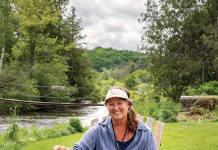As excellent as Michigan’s recreational fishing is — and it is — there’s something missing. Michigan was once the best place in the lower 48 to fish for Arctic grayling, a sport fish of exquisite beauty that is equally toothsome.
In the mid-1800s, sportsmen from around the country arrived by train to fish the rivers of the northern Lower Peninsula — mostly the Au Sable and Manistee — for this member of the salmon family that is distinguished primarily by a large dorsal fin, so prominent that the fish became known as the “sailfish of the north.” Grayling were so abundant and popular that the county seat of Crawford County was named for them.
But grayling had several factors working against them. They are easily caught, and with the dearth of fishing regulations in the 19th century, they were heavily exploited, shipped by the barrelful to major cities by rail. The species is environmentally sensitive and lumbering practices, including clear-cutting forests and floating logs down their rivers, destroyed their habitat as massive siltation covered their gravel spawning beds. To make matters worse, early fisheries managers introduced both rainbow and brown trout, which are more competitive, into the cold, clear-water streams grayling inhabited.

Those three factors were too much for the grayling; the last known wild grayling in Michigan was caught in the Upper Peninsula’s Otter River in Houghton County in 1936, where they probably were not even native but had been stocked.
Since that time, fisheries managers have made several attempts to re-introduce grayling to Michigan, the most recent in the late 1980s, but none met with success. But Montana’s recent success re-establishing grayling populations — the only other place in the continental United States where they are found — has fisheries managers optimistic that Michigan can get grayling back.
The Department of Natural Resources and the Little River Band of Ottawa Indians entered into a partnership agreement in 2016 to give grayling another go.
“It’s rolling,” said Todd Grischke, the assistant fisheries chief at the Michigan DNR, who said the Michigan Arctic Grayling Initiative now has 40 partners. “Things are starting to happen.”
“Grayling coexist with brook trout and brown trout in other places. But we’re dealing with established populations of trout in our streams, so that may be a major hurdle to get over.”
— Todd Grischke
Montana enjoyed success in repopulating grayling waters by utilizing remote site incubators in the streams targeted for stocking, Grischke said.
“They’re glorified 5-gallon buckets, really,” he said. “Fertilized eggs are placed in a mesh basket with gravel and the flow-through current. Right after they hatch, they become imprinted on that river as they move out of the bucket and into the stream. Montana’s had multiple years of natural reproduction.
“That technology is what we’re relying on.”
The partnership secured a grant from the Consumers Energy Foundation to evaluate the Upper Manistee River watershed, including more than 20 tributaries, and have concluded the habitat is proper for grayling.
A second grant from the Henry E. and Consuelo S. Wenger Foundation is funding a major research study at Michigan State University, where an artificial stream was created and fertilized eggs from Alaska (where grayling are bountiful) were obtained to study. The hatchlings are in the facility, and researchers have added some trout to see how they do.
“Grayling coexist with brook trout and brown trout in other places,” Grischke said. “But we’re dealing with established populations of trout in our streams, so that may be a major hurdle to get over. It is not our intention to eliminate existing fish populations and stock grayling in their place.”
Meanwhile, the DNR is planning a $1.1-million project at Oden State Fish Hatchery, including ultraviolet light equipment to kill any pathogens, where brood stock for future stocking endeavors will be held.

“We’re in the design phase right now,” Grischke said. “We started a nonprofit (called ReWild) to raise the money for it. It’s a $275,000 design project, and we’ve raised half the money.
“This is really taking a holistic approach, where we learn from past attempts and use modern-day technology to make it work. We’re trying to do this right.”
If the idea of floating a fly over grayling in Michigan whets your angling appetite, well, keep your shirt on, Grischke said.
“It’ll be years,” he said. “It’s probably in the neighborhood of five years before we have fish to put in a stream and potentially another five years before we’ll be able to fish for them. I don’t know if I’ll see this in my career.”
Still, Grischke is fired up. He’s urging grayling enthusiasts to be patient.
“This is a marathon, not a sprint,” he said.
Bob Gwizdz is an avid angler and career outdoor writer who lives in East Lansing with his wife Judy.








Facebook Comments